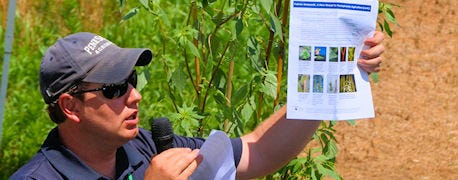July 24, 2014

Over the last two weeks, Penn State Extension weed specialists have heard numerous new reports of either Palmer amaranth or its close relative waterhemp cropping up in alfalfa, soybean and corn fields. Most were in the southeast region of the state where glyphosate failed to control targeted pigweed species. And as of early this week, some of those plants were more than 3-feet tall and beginning to flower, report PSU Weed Specialists Bill Curran and Dwight Lingenfelter.

ONE BIG BAD PLANT: If there was ever a weed to threaten current glyphosate-based weed control practices, it's the Palmer pigweed like the one standing behind Dwight Lingenfelter.
Most of the control failures were in soybean. But one incident was in established alfalfa, he adds.In this situation, the farmer noticed the problem earlier in the summer, applied Gramoxone after second cutting. It appeared to do a good job controlling emerged plants. But at third cutting, the field was loaded again with emerged plants.
Unsuspected alfalfa concern
"This is very concerning as we would assume that established alfalfa that's cut every 30-plus days might be a good management strategy for pigweed control," says Lingenfelter. "The farmer is going to treat again with Gramoxone after third cutting, but will add the Prowl residual herbicide.
In 2012, Kansas State University research compared a number of dormant and in-between cutting herbicides for control of Palmer amaranth in alfalfa. It confirmed that the weed can emerge in late summer. It also confirmed the need for residual control – even in alfalfa.
The best late-season Palmer amaranth control was achieved with sequential treatments that included flumioxaxin or diuron. Flumioxazin for alfalfa is sold as Chateau. It must be applied either during the dormant period or as soon as possible after cutting and removing alfalfa to minimize potential crop injury.
Diuron, sold as Karmex, isn't commonly used in alfalfa in this region, notes Lingenfelter. Several other treatments provided good early-season Palmer amaranth control, but control diminishes as the season progresses.
Bottom line: Palmer amaranth emerges throughout the growing season. Sequential herbicide treatments with good residual activity may be necessary for season-long control.
For more on IDing Palmer and its control, click on Pig_ugly_palmer.
You May Also Like




